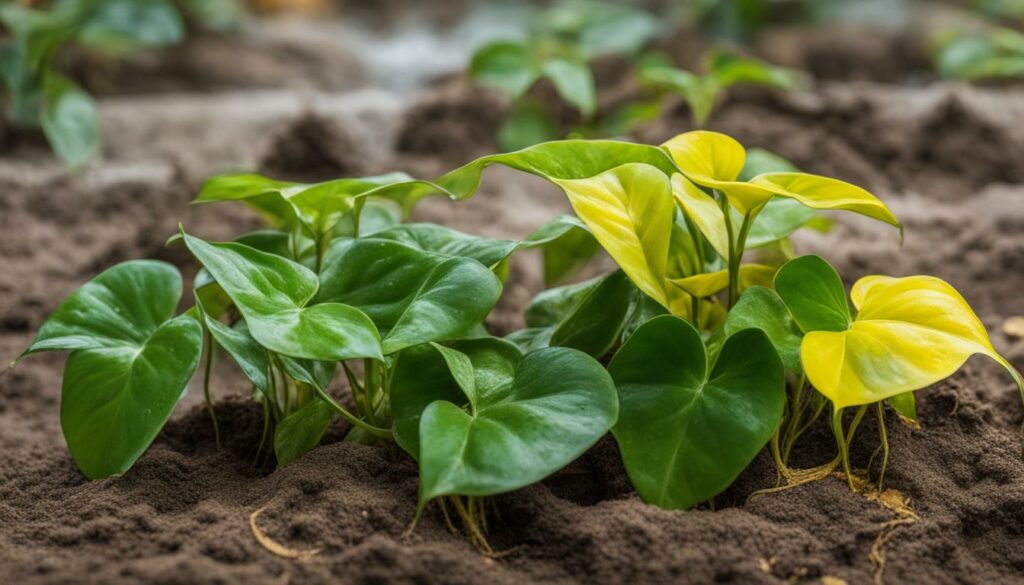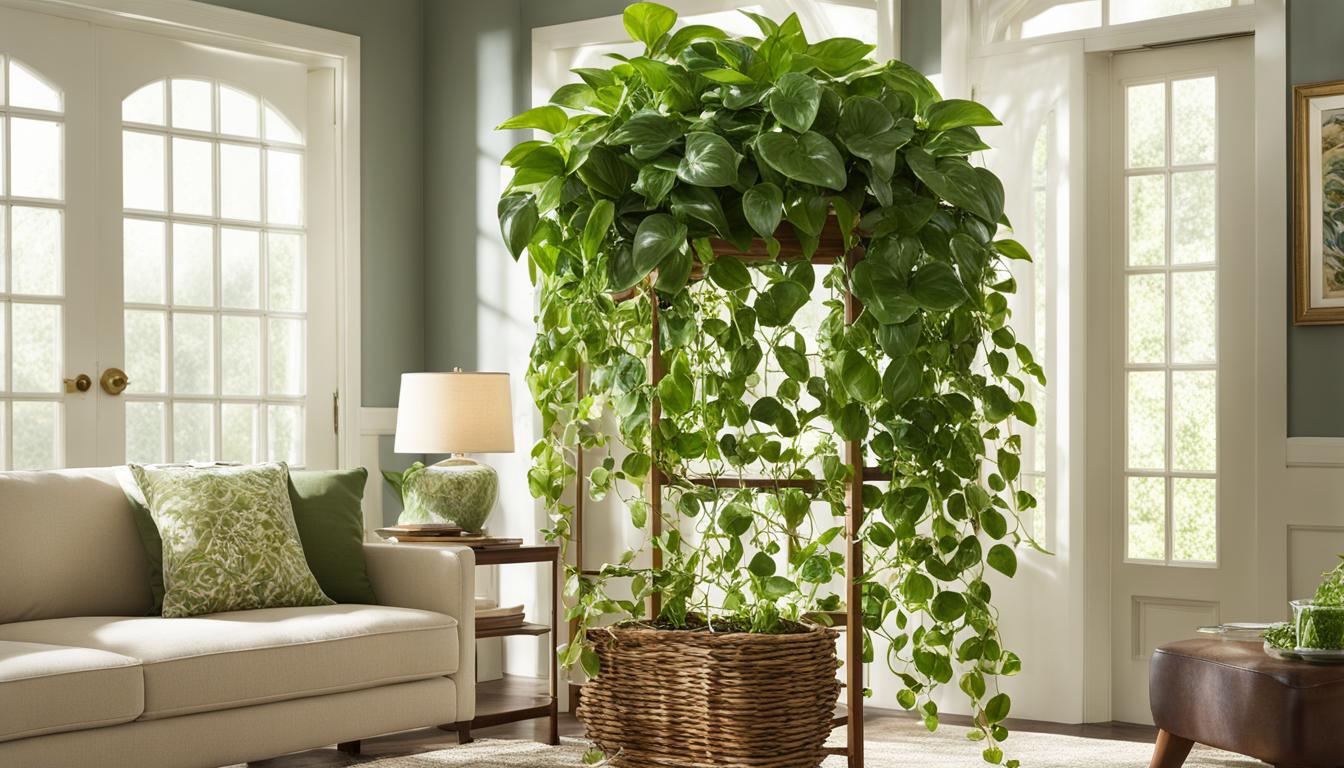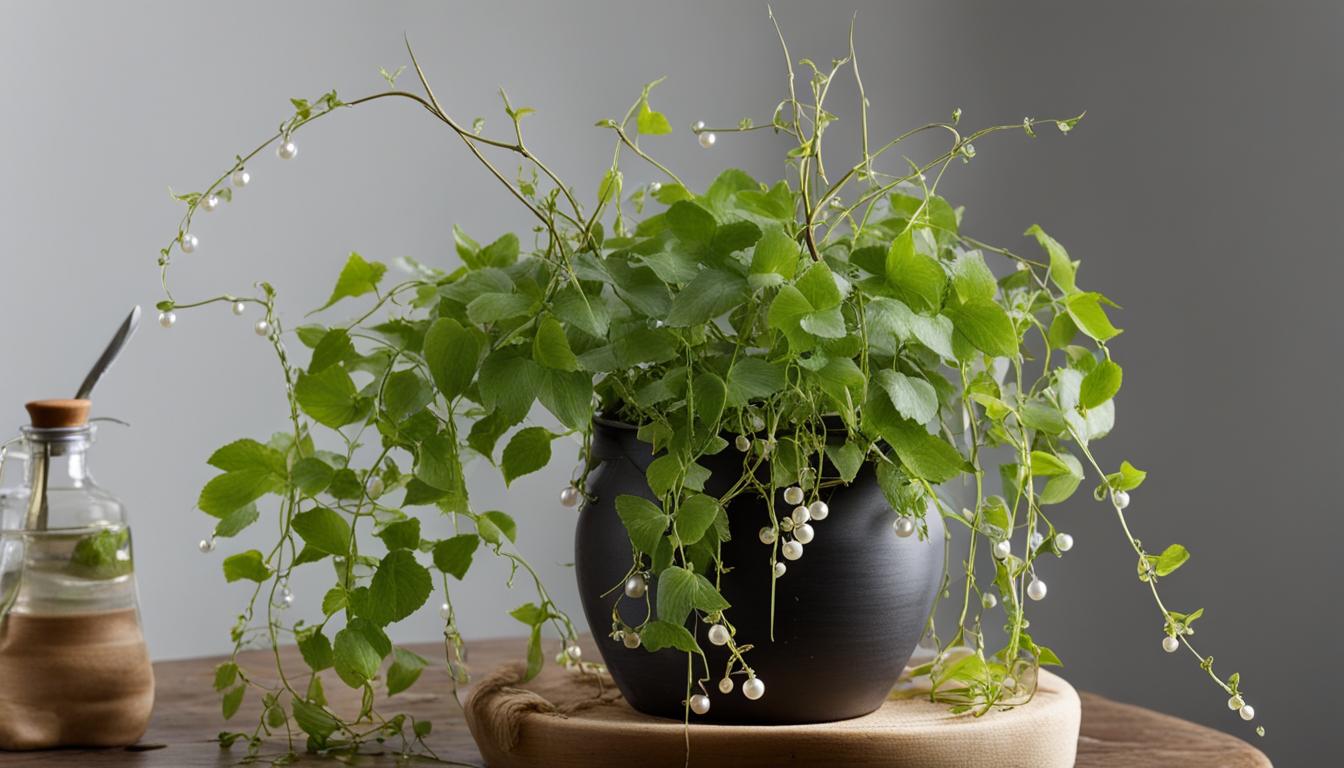Welcome to our guide on caring for your Pearls And Jade Pothos plant! As beautiful as these plants are, they can sometimes encounter a few hiccups along the way. In this section, we’ll explore the common problems that Pothos plant owners face and provide troubleshooting tips to help you keep your plant healthy and thriving.
From yellowing leaves to wilting and drooping, stunted growth to leaf discoloration, our Pearls And Jade Pothos plants can show a variety of symptoms. But don’t worry, we’re here to help you navigate through these issues!
To ensure that your Pothos plant stays in top shape, it’s important to understand the signs of trouble and how to address them. By doing so, you’ll be able to keep your plant looking vibrant and lush for years to come.
So, let’s dive in and discover how to solve common Pothos plant issues and ensure your Pearls And Jade Pothos plant thrives!
Overcoming Overwatering and Underwatering
One of the most common issues that Pothos plant owners face is overwatering and underwatering. Both of these problems can negatively impact the health and vitality of your Pearls and Jade Pothos plant. However, with proper care and attention, you can overcome these issues and ensure the optimal growth of your plant.
Overwatering: Overwatering can lead to root rot and yellowing leaves. To prevent overwatering, it is important to assess the soil moisture before watering. Stick your finger about an inch into the soil – if it feels dry, it’s time to water your plant. Additionally, make sure your pot has drainage holes to allow excess water to escape. Water your Pothos plant thoroughly but allow the top 1 to 2 inches of soil to dry out before watering again.
Underwatering: Underwatering can cause wilting and drooping of the leaves. To prevent underwatering, make sure you water your Pearls and Jade Pothos plant regularly. Check the soil moisture frequently and adjust your watering schedule accordingly. If the top layer of soil is dry, it’s time to give your plant a good drink. However, avoid overcompensating and flooding the plant with water, as this can lead to overwatering.
Remember, every Pothos plant is unique, and its water requirements may vary based on factors such as humidity levels and the size of the plant. By paying attention to the soil moisture and adjusting your watering practices accordingly, you can prevent both overwatering and underwatering and ensure the overall health and well-being of your Pearls and Jade Pothos plant.
Table: Signs of Overwatering and Underwatering in Pothos Plants
| Signs of Overwatering | Signs of Underwatering |
|---|---|
| Yellowing or browning leaves | Wilting and drooping leaves |
| Foul odor from the soil | Dry and crispy leaves |
| Mushy or slimy roots | Brittle and dull leaves |
| Slow or stunted growth | Soil pulling away from the edges of the pot |
By understanding the signs of overwatering and underwatering and taking appropriate measures to adjust your watering practices, you can ensure that your Pearls and Jade Pothos plant thrives and remains healthy.

Managing Pest Infestations
Pest infestations can be a common problem for Pearls and Jade Pothos plants. These pests can include fungus gnats, spider mites, and thrips. It is important to address these infestations promptly to prevent damage to your plant. Regular inspection is essential in identifying signs of pests such as webbing or small insects.
To get rid of pests on your Pothos plant, you can use natural pest control methods. Washing off the pests with water can help eliminate them. Additionally, using insecticidal soap or neem oil can be effective in controlling the infestation. Consistent vigilance and monitoring are key to keeping your Pothos plant pest-free.
Common Pests Affecting Pothos Plants
Here are some common pests that can affect your Pearls and Jade Pothos plants:
- Fungus Gnats: These small, flying insects are attracted to damp soil. They lay their eggs in the soil, and the larvae feed on organic matter and plant roots. Fungus gnats can cause damage to the roots and lead to stunted growth.
- Spider Mites: Spider mites are tiny pests that can infest the leaves of your Pothos plant. They feed on the plant sap, causing yellowing and discoloration of the leaves. Heavy infestations can result in webbing on the plant.
- Thrips: Thrips are slender insects that can cause damage to the leaves of your Pothos plant. They feed on the plant sap, leaving behind silver or bronze-colored streaks on the leaves.
Preventing pest infestations is crucial for the overall health of your Pothos plant. Regularly inspecting your plant, maintaining proper hygiene, and ensuring a clean environment are important preventive measures. Additionally, avoid overwatering your plant, as excess moisture can attract pests. By implementing these preventive measures and promptly addressing pest infestations, you can keep your Pearls and Jade Pothos plant thriving.
| Pest | Description | Symptoms |
|---|---|---|
| Fungus Gnats | Small, flying insects attracted to damp soil | Yellowing leaves, stunted growth |
| Spider Mites | Tiny pests that infest the leaves | Yellowing, discoloration, webbing on plant |
| Thrips | Slender insects that damage leaves | Silver or bronze-colored streaks on leaves |
Preventive Care and Maintenance
Proper care and maintenance are vital for the health and longevity of your Pearls And Jade Pothos plant. By following a few simple tips, you can ensure that your Pothos remains healthy and vibrant for years to come.
First and foremost, pay attention to watering. Overwatering can lead to root rot and other issues, while underwatering can cause wilting and drooping. It’s best to water your Pothos thoroughly and allow the top inch or two of soil to dry out before watering again.
Additionally, provide the right amount of light for your Pothos. These plants thrive in bright, indirect light, so placing them near a north or east-facing window is ideal. Avoid direct sunlight, as it can scorch the leaves.
Maintaining adequate humidity levels is also important for Pothos plants. These tropical plants prefer higher humidity, so consider misting the leaves or placing a tray of water near the plant to increase moisture in the air.
Regular pruning is another key aspect of Pothos plant care. Trim any yellow or brown leaves, as well as any leggy or overgrown stems, to promote healthy growth. You can also propagate cuttings to create new plants.
Lastly, be mindful of nutrient deficiencies. Pothos plants benefit from regular fertilization with a balanced fertilizer or by adding compost to the soil. This will help provide the necessary nutrients for healthy growth.
By implementing these tips and taking a proactive approach to care and maintenance, you can prevent common issues and ensure that your Pearls And Jade Pothos plant thrives in any environment.
FAQ
What are some common issues that Pearls and Jade Pothos plants may encounter?
Common issues include yellowing leaves, wilting and drooping, stunted growth, leaf discoloration, pest infestations, and nutrient deficiencies.
How can I prevent overwatering and underwatering my Pearls and Jade Pothos plant?
To prevent overwatering and underwatering, assess soil moisture before watering, allow the top 1 to 2 inches of soil to dry out between waterings, and repot with well-draining soil if necessary.
What pests can affect Pearls and Jade Pothos plants, and how can I manage them?
Common pests include fungus gnats, spider mites, and thrips. To manage pests, regularly inspect your plant for signs, wash off pests with water, or use insecticidal soap or neem oil.
What preventive care and maintenance should I provide for my Pearls and Jade Pothos plant?
Provide proper watering, light, humidity levels, regular pruning, repot when necessary, and address nutrient deficiencies with a balanced fertilizer or composting.



